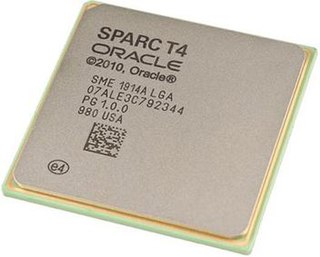
Sun Microsystems, Inc., was an American technology company that sold computers, computer components, software, and information technology services and created the Java programming language, the Solaris operating system, ZFS, the Network File System (NFS), and SPARC microprocessors. Sun contributed significantly to the evolution of several key computing technologies, among them Unix, RISC processors, thin client computing, and virtualized computing. Notable Sun acquisitions include Cray Business Systems Division, Storagetek, and Innotek GmbH, creators of VirtualBox. Sun was founded on February 24, 1982. At its height, the Sun headquarters were in Santa Clara, California, on the former west campus of the Agnews Developmental Center.

SPARC is a reduced instruction set computer (RISC) instruction set architecture originally developed by Sun Microsystems. Its design was strongly influenced by the experimental Berkeley RISC system developed in the early 1980s. First developed in 1986 and released in 1987, SPARC was one of the most successful early commercial RISC systems, and its success led to the introduction of similar RISC designs from many vendors through the 1980s and 1990s.

Solaris is a proprietary Unix operating system originally developed by Sun Microsystems. After the Sun acquisition by Oracle in 2010, it was renamed Oracle Solaris.
HotSpot, released as Java HotSpot Performance Engine, is a Java virtual machine for desktop and server computers, developed by Sun Microsystems and now maintained and distributed by Oracle Corporation. It features improved performance via methods such as just-in-time compilation and adaptive optimization.

The Sun Ray was a stateless thin client computer aimed at corporate environments, originally introduced by Sun Microsystems in September 1999 and discontinued by Oracle Corporation in 2014. It featured a smart card reader and several models featured an integrated flat panel display.

Sun Microsystems' UltraSPARC T1 microprocessor, known until its 14 November 2005 announcement by its development codename "Niagara", is a multithreading, multicore CPU. Designed to lower the energy consumption of server computers, the CPU typically uses 72 W of power at 1.4 GHz.

Sun Microsystems' UltraSPARC T2 microprocessor is a multithreading, multi-core CPU. It is a member of the SPARC family, and the successor to the UltraSPARC T1. The chip is sometimes referred to by its codename, Niagara 2. Sun started selling servers with the T2 processor in October 2007.
Solaris Containers is an implementation of operating system-level virtualization technology for x86 and SPARC systems, first released publicly in February 2004 in build 51 beta of Solaris 10, and subsequently in the first full release of Solaris 10, 2005. It is present in illumos distributions, such as OpenIndiana, SmartOS, Tribblix and OmniOS, as well as in the official Oracle Solaris 11 release.

SunPCi is a series of single-board computers with a connector that effectively allows a PC motherboard to be fitted in Sun Microsystems SPARC-based workstations based on the PCI architecture adding the capability for the workstation to act as a 'IBM PC compatible' computer. The Sun PCi cards included an x86 processor, RAM, expansion ports, and an onboard graphics controller, allowing a complete Wintel operating environment on a Solaris system. The SunPCi software running on Solaris emulates the disk drives that contain the PC filesystem. The PC software running on the embedded hardware is displayed in an X window on the host desktop; there is also a connector on the edge of the board that can optionally be used to connect a PC monitor.
Solbourne Computer, Inc. was originally a vendor of computer systems based in Longmont, Colorado, United States, at first 52% owned by Matsushita. In the late 1980s and early 1990s, the company produced a range of computer workstations and servers based on the SPARC microprocessor architecture, largely compatible with Sun Microsystems' Sun-4 systems. Some of these are notable for supporting symmetric multiprocessing some time before Sun themselves produced multiprocessor systems. Even when Sun produced multiprocessor systems, SunOS uses an asymmetric multiprocessing model rather than OS/MP's symmetric multiprocessing model; Sun would not adopt symmetric multiprocessing until the release of Solaris 2.0 in 1992. Due to the cost of engineering and producing new systems to compete with Sun's increasingly competitive hardware offerings and the loss of symmetric multiprocessing as a distinguishing feature, in 1994, Solbourne left the computer hardware business, with Grumman Systems Support Corporation taking over support for Solbourne customers until 2000.
Logical Domains is the server virtualization and partitioning technology for SPARC V9 processors. It was first released by Sun Microsystems in April 2007. After the Oracle acquisition of Sun in January 2010, the product has been re-branded as Oracle VM Server for SPARC from version 2.0 onwards.
The SPARC Enterprise series is a range of UNIX server computers based on the SPARC V9 architecture. It was co-developed by Sun Microsystems and Fujitsu, announced on June 1, 2004, and introduced in 2007. They were marketed and sold by Sun Microsystems, Fujitsu, and Fujitsu Siemens Computers under the common brand of "SPARC Enterprise", superseding Sun's Sun Fire and Fujitsu's PRIMEPOWER server product lines. Codename is APL.
Oracle Developer Studio, formerly named Oracle Solaris Studio, Sun Studio, Sun WorkShop, Forte Developer, and SunPro Compilers, is the Oracle Corporation's flagship software development product for the Solaris and Linux operating systems. It includes optimizing C, C++, and Fortran compilers, libraries, and performance analysis and debugging tools, for Solaris on SPARC and x86 platforms, and Linux on x86/x64 platforms, including multi-core systems.
Sun xVM was a product line from Sun Microsystems that addressed virtualization technology on x86 platforms. One component was discontinued before the Oracle acquisition of Sun; the remaining two continue under Oracle branding.
Sun Open Storage was an open source computer data storage platform developed by Sun Microsystems. Sun Open Storage was advertised as avoiding vendor lock-in.
Afara Websystems Inc. was a Sunnyvale, California, USA server company whose goal was to build servers surrounding a custom high-throughput CPU architecture, "developing IP traffic management systems that will bring quality-of-service to the next generation of IP access infrastructure." The word "Afara" means "bridge" in the West African Yoruba language.

The SPARC T3 microprocessor is a multithreading, multi-core CPU produced by Oracle Corporation. Officially launched on 20 September 2010, it is a member of the SPARC family, and the successor to the UltraSPARC T2.

The SPARC T4 is a SPARC multicore microprocessor introduced in 2011 by Oracle Corporation. The processor is designed to offer high multithreaded performance, as well as high single threaded performance from the same chip. The chip is the 4th generation processor in the T-Series family. Sun Microsystems brought the first T-Series processor to market in 2005.
The SPARC T-series family of RISC processors and server computers, based on the SPARC V9 architecture, was originally developed by Sun Microsystems, and later by Oracle Corporation after its acquisition of Sun. Its distinguishing feature from earlier SPARC iterations is the introduction of chip multithreading (CMT) technology, a multithreading, multicore design intended to drive greater processor utilization at lower power consumption.

SPARC T5 is the fifth generation multicore microprocessor of Oracle's SPARC T series family. It was first presented at Hot Chips 24 in August 2012, and was officially introduced with the Oracle SPARC T5 servers in March 2013. The processor is designed to offer high multithreaded performance, as well as high single threaded performance from the same chip.








